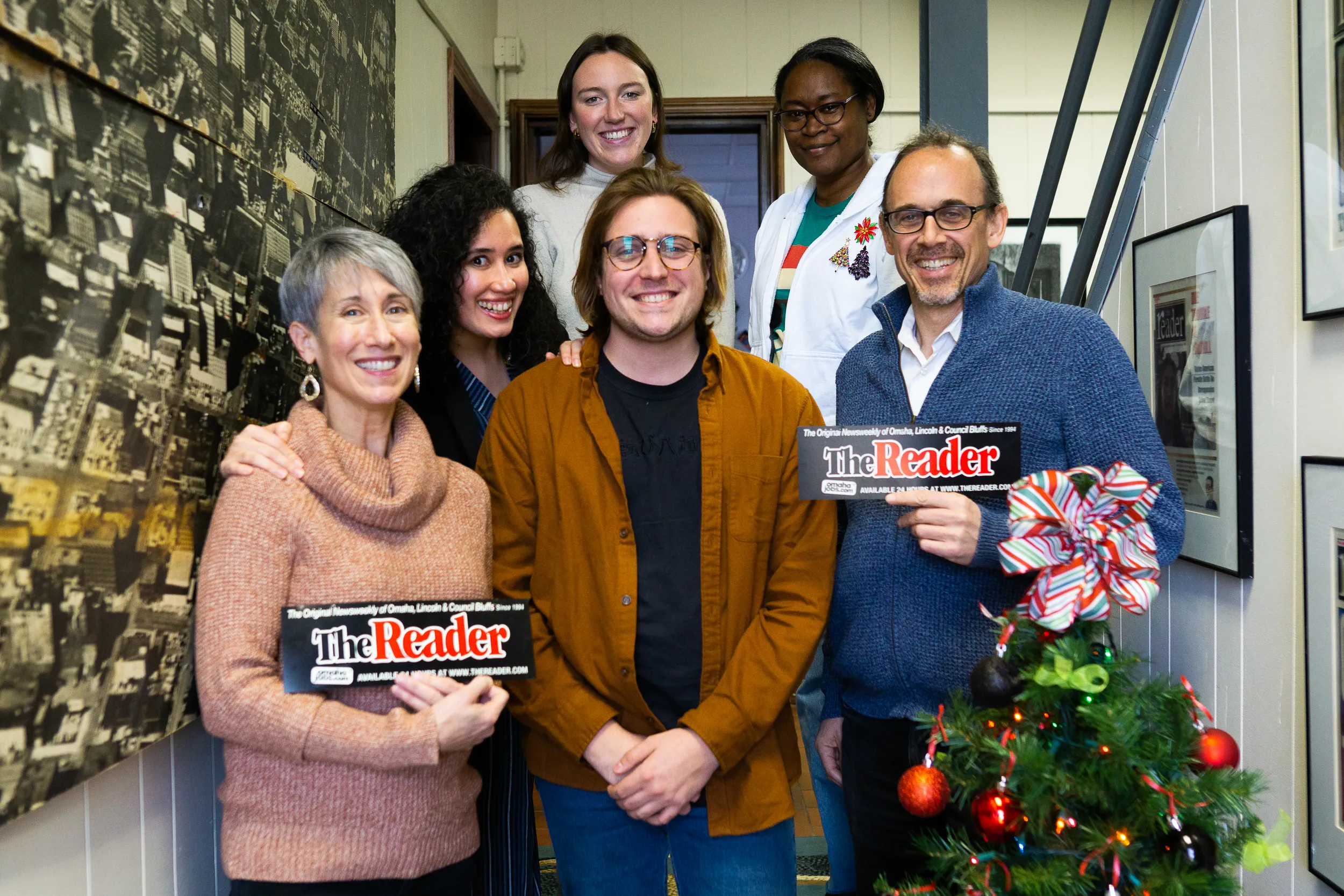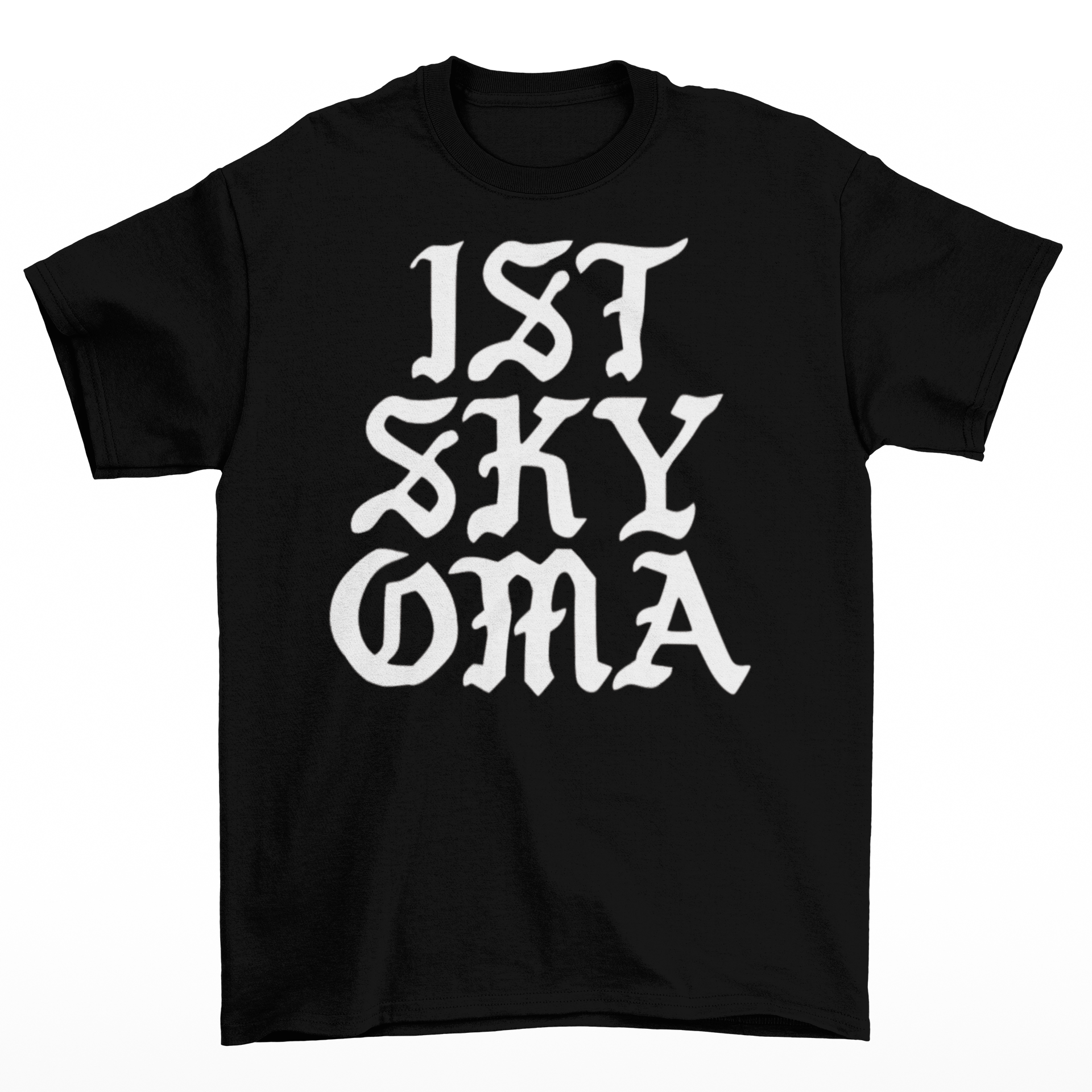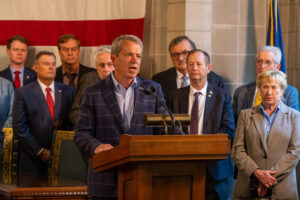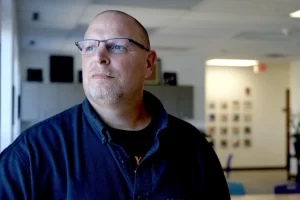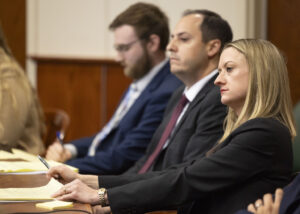By Erin Grace
Flatwater Free Press
John Heaston opens the door to a brick warehouse next to Johnny’s Cafe in South Omaha and walks through rooms holding his life’s work.
“It’s kind of a hot mess,” says the 52-year-old longtime publisher of Omaha’s alternative newspaper, The Reader.
Here’s a garage bay holding empty green newspaper boxes emblazoned with the word, “FREE.” Here are floor-to-ceiling shelves stacked with yellowing copies of The Reader and El Perico, a separate publication that Heaston owns.
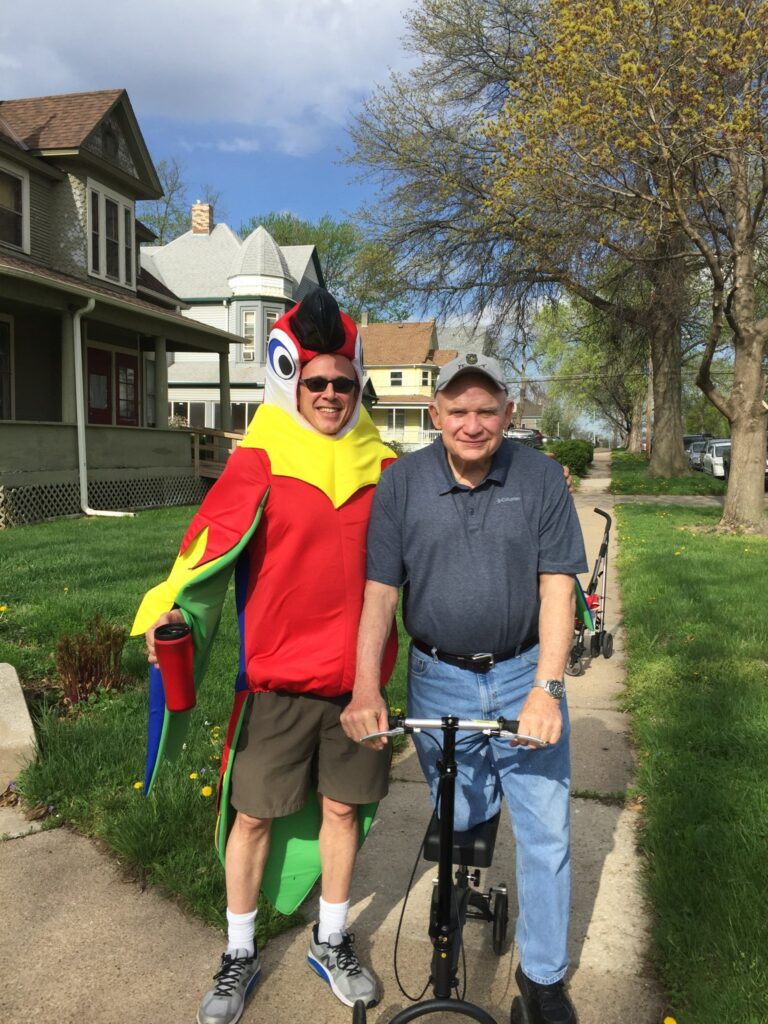
Sticky notes scribbled with years like 1998, 2012 and 2016 aim to bring some order to the chaos of the last three decades. Headlines about the latest “CD” review or Ranch Bowl show or wacky trend or controversial city issue take a visitor through Omaha history. The J. Doe civic art project statues. The band 311. Dubious landlords.
Heaston had spent months organizing and preparing to end an effort that began in the halcyon Gen X grunge days of the early 1990s, when he was a University of Nebraska at Omaha student.
Heaston had wanted to shine a light on Omaha culture, nightlife and issues he felt were ignored. He had wanted to give voice to a host of writers outside the mainstream press. (I was one of those writers. Heaston, the brother of a friend, gave me my first Omaha byline in an embarrassingly overwritten piece on alternative theater.)
Later in his career, he focused on communities that wanted their own news coverage. (Heaston is also currently consulting for Flatwater Free Press.)
Like the fading copies before him, Heaston had considered his own body’s wear. A leukemia diagnosis in 2020, a bone marrow transplant in 2022 and a prognosis of more treatment made him announce in May that the monthly Reader/El Perico was ending. Its last issue printed Thursday.
Unless someone buys the operation — Heaston said recently he was “still talking” to a prospect — this marks the end of an era for Omaha news. The Reader archives will live on at its website and, eventually, the Omaha Public Library.
Heaston and his flagship publication have faced the same headwinds battering legacy news outlets. Like them, The Reader changed. It moved partly online, shrunk in size, went from a weekly print edition to monthly, figured out how to scrape by as print advertising disappeared.
The public now consumes news in kaleidoscopic fashion, grabbing bits and shards from online outlets. Alternative newspapers that sprang up in the 1960s have shrunk and some big names have disappeared.
But the Army brat born in Germany and raised in four other states until landing in Omaha to attend Creighton Prep had found a way to keep The Reader going.
It’s his health, he said, not the topsy-turvy industry, that led him to stop the presses.
“Right now I’m fine,” Heaston said in late July. “The thing about cancer is, you never know.”
Later this month, he will travel to New York City’s Memorial Sloan Kettering Cancer Center to speak with the foremost expert in his type of cancer.
Those who know Heaston describe a hard-driving ideas man who both charms with buoyant charisma and frustrates with a constant on-switch that makes keeping up difficult.
He has an uncanny ability to mobilize support around the mission of journalism.
Chris Bowling, who has worked as investigative reporter, ad salesman and as The Reader’s likely final news editor, said Heaston “saddles people with a lot of work. … But he really has this unbridled belief that if we work really hard we can get this done.”
The payoff, for Bowling, was investigative projects like one he’d done on landlords running afoul of city housing codes. He was proud of the reaction it garnered, which told him the story mattered.
Terri Sanders, owner and publisher of the Omaha Star, served on a board with Heaston. She respects him despite clashing with him on a couple issues – like publication schedule.
“Just lately John called me,” she said. “He said, ‘I owe you an apology.’ I did appreciate that.”
In an essay he wrote for Editor & Publisher in March, Heaston gave a similar account.
“When MAWGs get out of the way,” he wrote, using an acronym for middle-aged white guys, “great things can happen … Publisher Terri D. Sanders has opened a number of new revenue streams I couldn’t have imagined. Again, I’m the one learning.”
Heaston hadn’t planned to become a journalist. He’d partied away a scholarship at a Texas university, tried “the ski bum thing” in Colorado and wound up at UNO, where he became director of student programming.
He loved events, and Omaha’s alternative music scene in the early 1990s was on the rise before the Saddle Creek Records explosion. Bright Eyes. Cursive. The Faint.
“There was, like, this cultural moment in Omaha where there was a lot of music that had no place to go,” Heaston said.
Heaston became familiar with smaller venues. When the audience grew, he tried booking the 1,400-capacity Sokol Hall for New Year’s Eve 1990 and was turned away. The reason? It was closing.
He was told the building, dating to 1926, needed over $1 million in repairs. Rumor had it a McDonald’s was going in.
Heaston couldn’t believe Omaha would lose the landmark. He called a tip into the Omaha World-Herald, which ran a story proclaiming the old Bohemian-built polka hall and gymnastics venue was “Czeching out.” It seemed like an obituary.
Heaston complained to anyone who would hear.
Someone said, “You should do your own paper.” This was the seed.
In 1992, he produced his first issue of a first alternative newspaper, Sound News and Arts. It was a nonprofit, volunteer-run collective printed monthly.
Sound was successful, but the all-volunteer-staff started graduating college and disappearing.
Several businessmen approached Heaston about keeping the effort going. They saw an advertising winner. Omaha, at the time, was one of only two major U.S. cities without an alternative newspaper.
In 1993, Heaston dropped out of college, nine credits short of a finance degree.
In 1994, the group launched The Reader.
“We just took off,” he said.
For two years, Heaston worked overnights at a group home for developmentally delayed adults to pay the bills. He did the newspaper’s operation work during the day. By 1996, The Reader could stand alone as a weekly paper. Heaston started taking a paycheck.
The Reader began attracting pro journalists who didn’t fit at legacy outlets. Heaston’s role was Swiss Army Knife: news reporter, editor, publisher, owner.
In 1999, Heaston started a different alternative, the Omaha Weekly, after a business partner bought out his stake in The Reader. Then, in 2002, Heaston bought back The Reader and merged the papers.
At the time, according to a World-Herald report, The Reader was a 14-employee operation with a 25,000-paper Tuesday press run handed out for free. The Omaha Weekly was a five-employee operation with a circulation of 16,000.
“Such an era,” said cookbook author Summer Miller, who worked there as a writer and editor in the early 2000s.
Miller recalled how Heaston could mobilize a team around a cause and start things, like the Omaha Entertainment and Arts Awards.
“He’s an ideas person,” she said. “Even if he’s only executed on a small fraction of the millions of ideas he had and visions and dreams, they’ve all been placed to make Omaha better.”
Heaston became more involved in publications serving minority communities.
In 2004 he bought El Perico from Marcos Mora, who had launched the Spanish-English publication.
“It wasn’t like anybody got rich or anything,” said Mora. “His love for journalism, that’s what resonated with me. Keeping that alive.”
As print ad revenue began to dry up, Heaston diversified funding, buying omahajobs.com in 2005 and building a search engine optimization and marketing consulting business.
In recent years, Heaston took on leadership roles at the Association for Alternative Newsmedia, which he led during the pandemic. He formed collaborations with the national Black and Hispanic press organizations. He was instrumental in helping secure Google News Initiative funding.
Casey Pallenik, news industry relations manager for the Google News Initiative, said Heaston stood out among news industry leaders.
“He had no problem texting, any time of the day or night,” she said. “He has done everything he possibly can to advocate … and help others.”
Then came 2020. Heaston’s father, Bill, died of cancer. The pandemic hit. Heaston himself, feeling unwell, got a diagnosis: chronic myeloid leukemia, a largely survivable cancer.
Until, for him, it wasn’t. His medications quit working in 2021. He developed a mutation that made his cancer aggressive and resistant. He documented this in The Reader, charting an ordeal that at times meant 40 pills a day, weight loss and having the precarious immune system of a newborn. The bone marrow transplant brought better health. He’s not out of the woods.
Through it all, Heaston remains buoyant despite stepping away from The Reader/El Perico to “future proof my life.”
He’s still bullish on the prospects for local news and alternative news.
Yes, he said, a massive shift is underway in media production and consumption. He said many outlets will likely keep shrinking. But this opens room to different forms of storytelling.
“Where journalism is going — the biggest stories of our life are broken with someone with a phone on the street,” he said. “Why can’t we help people tell their own stories? When we have a process to verify them, we can elevate them and make it a lot more useful for an audience, then we’ve got a pretty bright future.”
John Heaston is ending The Reader. But he is not out of ideas. The Flatwater Free Press is Nebraska’s first independent, nonprofit newsroom focused on investigations and feature stories that matter.

